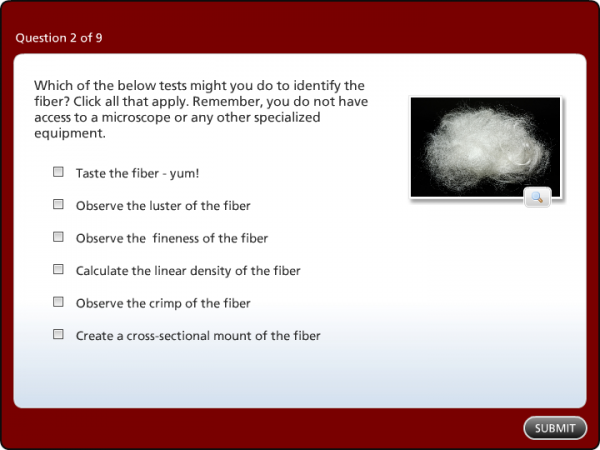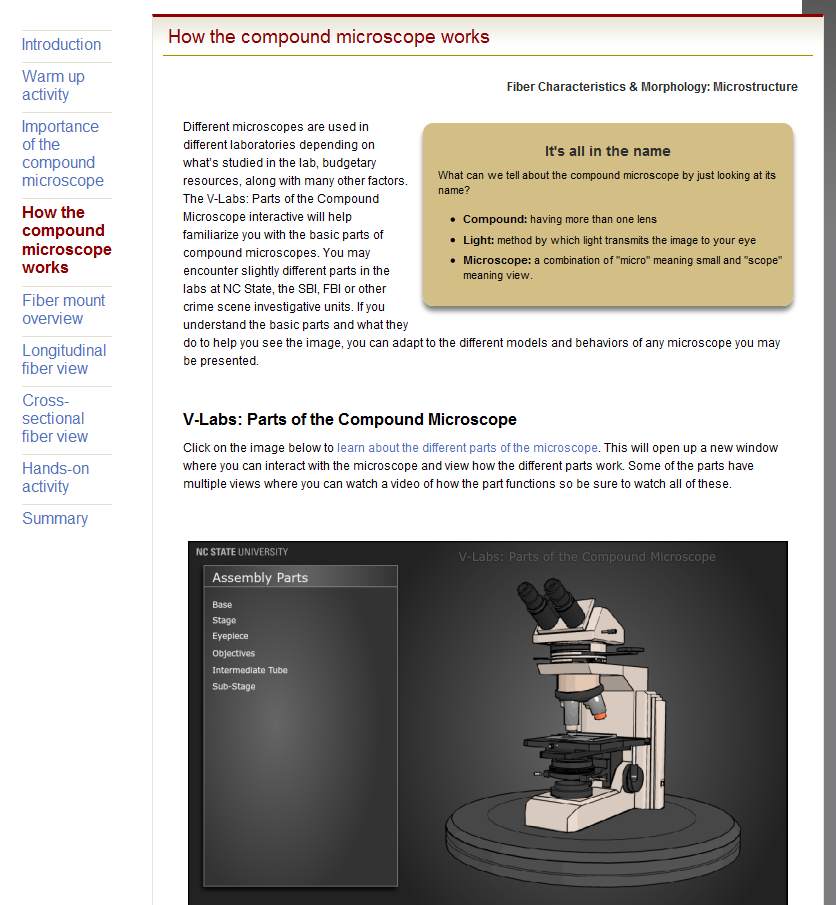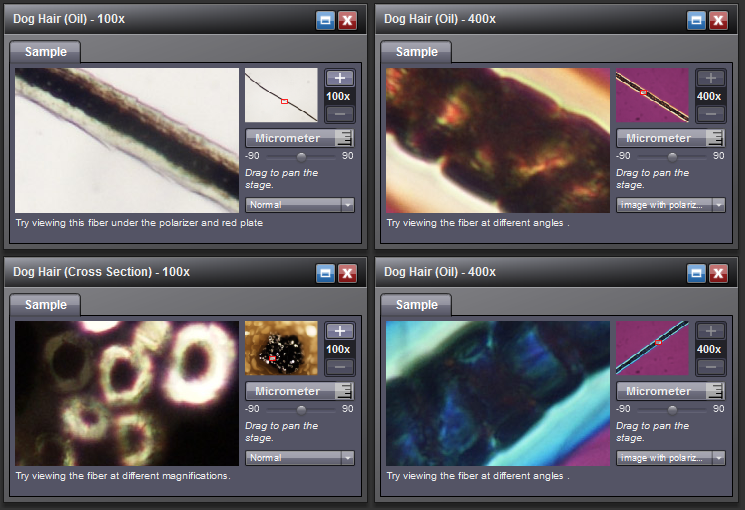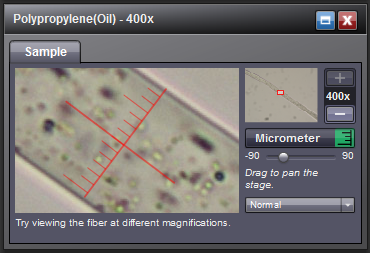TMS 211 – Weaving an integrated course
Distance education has come a long way since Dr. Jon Paul Rust, the head of the Textile Engineering, Chemistry and Science (TECS) department, started teaching Introduction to Fiber Sciences (TMS 211) via post more than 20 years ago. Back then, lectures were delivered on VHS tapes in the mail and laboratory exercises were completed wherever students could enlist the use of a compound microscope.
Nowadays, almost the entire course is taught online. And while the Postal Service may be missing the exercise, DELTA got a solid workout with TMS 211. The course primarily covers “the physical properties of textile fibers and their role as raw materials for forming complex textile structures.” Nearly 300 students, typically first- or second-semester sophomores, take the course every year, according to Rust. With such a high volume of students enrolling in the course, a revision of the delivery method was imminent.
This is one of the reasons that inspired Shawn Dunning, assistant dean for information technology at the College of Textiles, to apply for a grant toward developing an online version of the course. The first batch of students is going through the online version of the course, which includes online lessons and a weekly lab section, during the spring semester of 2011. Maintaining the hands-on experience of a lab section was a challenge for this course because the lab uses stationary equipment like compound microscopes. Even still, Dunning kept a positive outlook on the project.
“I really felt like we could teach the class as well, if not better, online,” said Dunning. To create the ideal experience, the course was started from the ground-up instead of adapting the classroom lectures. Working together with Rust and DELTA, he pushed the course and laboratory component through a smooth construction.
The core of the course is redesigned into a Moodle page integrating different elements including videos, animations, exercises and text into a web-based textbook. Students complete most of the lab section at home, either through online resources, with provided lab materials, or on campus during laboratory evaluations. Each week students complete a lesson, quiz, class poll and other activities.

Ruth Smith, an instructional designer and project manager at DELTA, helped Rust and Dunning redefine the learning objectives for the course. “We had to think about how content would be presented, how students would practice the material, and how to assess it,” said Smith. Together, they worked toward incorporating elements to ensure students could achieve these objectives.
Ruth Smith teamed up with Amanda Robertson, senior multimedia specialist and art director, and modified the basic Moodle book layout for this course by adding structure to the activities, such as: an introduction, a summary section, and call-outs for objectives. “We took the analogy of basic textbooks and applied it to the page layout,” said Smith.
The lessons incorporate videos, animations and an auto-linking glossary system, which Dunning hopes to use in other courses. Dana Hartweg, a multimedia specialist in the college of textiles, recorded several instructional videos to be integrated into the site. Making the Moodle site accessible and reusable were concerns when designing the course and that special attention seems to have paid off. “A lot of the complaints I’ve read in Technician are not applicable to our course because of the way it’s laid out,” said Dunning.

DELTA also worked on incorporating lab components of the laboratory into the main course. Currently, the course has 3 required on-site lab sessions, with online components to complement each. The team decided that it “wanted both of them together, a connection between the lab and the lecture as an integrated approach,” Smith said. Used to examine the structural characteristics of individual fibers, the compound microscope is the keystone of the lab experience. But replicating the feel and utility of the microscope proved a unique challenge.
To address this, the multimedia team at DELTA developed a slide viewing application. To get a good idea of what the program should be like, Benjamin Huckaby, a multimedia specialist, said that he went to the textile lab and completed exactly what the students went through in the lab. With this experience he was able to focus on “what students were actually getting from the microscope.”
Using this experience and information from Rust and Dunning the multimedia team created the “Virtual Microscope,” a browser-based application, allowing users to view and compare up to four slides at a time at magnifications 100 and 400 times their original size. David Tredwell, another multimedia specialist, helped set up some of the XML code and David Drewes, an intern at DELTA, helped skin the interface. Ruth Smith provided feedback on the interface of the application.
Originally developed for this course, the Virtual Microscope makes it possible examine 30 slides at any time, without a microscope. Because it is not an 1:1 emulation of a regular microscope, the team was able to add features unavailable on conventional microscopes.

Many of these features make distinguishing the intricate characteristics of fibers much easier. The ability to directly compare different slides side-by-side highlights the differences between them. The polarizer and the analyzer features are used to elucidate hard-to-see details. “The polarizer and analyzer are used to identify what fiber you have,” said Rust. “They all have a fingerprint as far as the optical properties of each fiber.”
These traits are indistinguishable with the naked eye or worse, a poor slide. For example, “it’s really hard to see the lumen of cotton in a cross section,” said Dunning. “You’ll have hundreds of fibers in there and it’s hard to pick one out.”
While students are still evaluated on their ability to create good slides, whether or not they can won’t get in the way of their learning experience. In fact, Dunning plans on using the Virtual Microscope in a fiber library for textile students.“If we take enough time as faculty and staff to create really good images then we can take away a good bit of that impedance to learning,” said Rust.
According to Huckaby, adding in features like rotational viewing into modular “tabs” within the application is fairly easy. Because the tabs are actually stored in external files, “you can really just change two or so lines of code and the new material can be in there and working,” he said. One such feature that he added was the “micrometer,” a microscopic ruler used to measure the width of samples.

Because the Virtual Microscope is accessible anytime students have access to a computer, it also works as a reference. Students can refer to images of the slides at any time from a computer. This is a definite improvement over the way slides were previously recorded. “Before you would have sketched it with color pencils but with this you can have the actual slide of the fibers,” said Dunning.
Both Rust and Dunning think that the Virtual Microscope, not only to Introduction to Fiber Science students, but to all textile science students. “I think that it is a useful tool. We’re going to use it as a fiber library in the future,” said Dunning. Because the Virtual Microscope wasn’t designed to emulate a regular microscope, it has the capability to display images up to magnifications as high as an electron microscope.
Given the positive feedback so far, the Virtual Microscope is up for a few more potential uses. Fortunately, adaptability was one of the goals in creating content for this course. “From the beginning, our goal was to build it (the Virtual Microscope) in as modular a fashion as possible,” Huckaby said. “We’re hoping that this will keep going and that we’ll be able to add more functionality to it and adapt it to faculty’s needs,” he said.
The application is easily scalable, with potential applications in other science courses, political science courses (as a map viewer) and in art history classes (as a high-res image viewer). As for modifying its implementation in TMS 211, it may have to wait for course evaluations to roll in.
“We’re kind of treading ahead right now,” says Dunning. But after the first phase, there will be a lot of evaluation to be done. To gather feedback on the Virtual Microscope, Training and Development Online is conducting a survey of the students’ experience with it.Dunning is interested in how the students’ experience with TMS 211 will compare to their other experiences with distance education courses. “I’d like to enhance the points that they think are good and eliminate the points that they think are bad,” he said.
Assessing and refining a course is essential to getting a good balance and progression of material. “I think there’s room for improvement in how we mix all the different teaching tools in each unit,” said Rust. The hope is that the online version serves as a good analog to the physical lecture and lab. “I think DELTA has done an excellent job of bringing all of their technologies together to deliver the material in a superior manner,” he said.
- Categories:


